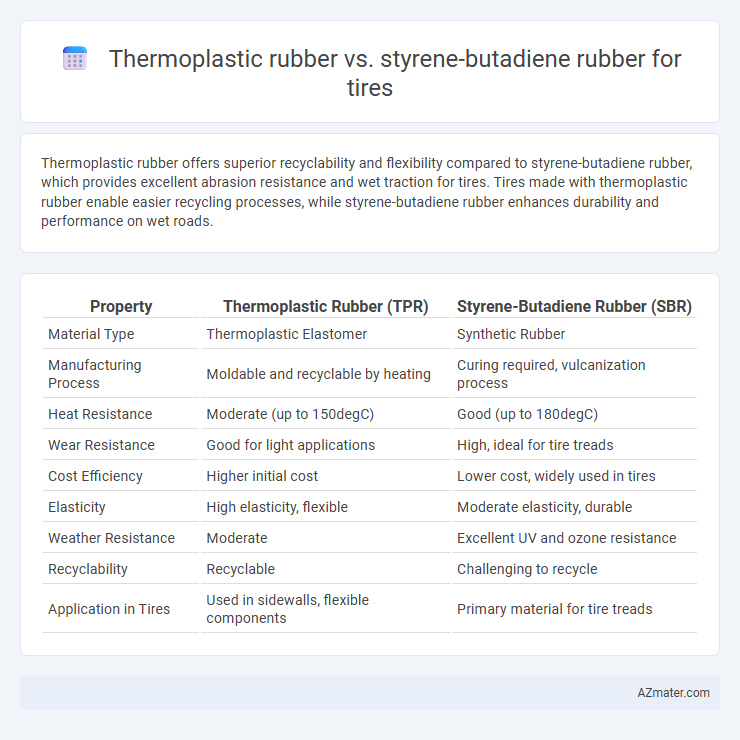Thermoplastic rubber offers superior recyclability and flexibility compared to styrene-butadiene rubber, which provides excellent abrasion resistance and wet traction for tires. Tires made with thermoplastic rubber enable easier recycling processes, while styrene-butadiene rubber enhances durability and performance on wet roads.
Table of Comparison
| Property | Thermoplastic Rubber (TPR) | Styrene-Butadiene Rubber (SBR) |
|---|---|---|
| Material Type | Thermoplastic Elastomer | Synthetic Rubber |
| Manufacturing Process | Moldable and recyclable by heating | Curing required, vulcanization process |
| Heat Resistance | Moderate (up to 150degC) | Good (up to 180degC) |
| Wear Resistance | Good for light applications | High, ideal for tire treads |
| Cost Efficiency | Higher initial cost | Lower cost, widely used in tires |
| Elasticity | High elasticity, flexible | Moderate elasticity, durable |
| Weather Resistance | Moderate | Excellent UV and ozone resistance |
| Recyclability | Recyclable | Challenging to recycle |
| Application in Tires | Used in sidewalls, flexible components | Primary material for tire treads |
Introduction to Tire Rubber Materials
Thermoplastic rubber (TPR) and styrene-butadiene rubber (SBR) are essential materials in modern tire manufacturing, each offering unique properties that influence tire performance. SBR, a synthetic rubber, provides excellent abrasion resistance and aging stability, making it a common choice for tread compounds. Thermoplastic rubber combines the elasticity of conventional rubber with the processing advantages of thermoplastics, enabling easier recyclability and enhanced design flexibility in tire components.
Overview of Thermoplastic Rubber
Thermoplastic rubber (TPR) combines the elasticity of rubber with the recyclability of thermoplastics, making it a versatile material in tire manufacturing. Its ability to be repeatedly melted and reshaped without significant degradation provides advantages in sustainability and production efficiency. Compared to styrene-butadiene rubber (SBR), TPR offers improved processability and potential for weight reduction in tires, contributing to better fuel efficiency.
Overview of Styrene-Butadiene Rubber (SBR)
Styrene-Butadiene Rubber (SBR) is a synthetic rubber widely used in tire manufacturing due to its excellent abrasion resistance and aging stability, making it ideal for tread compounds. Its copolymer structure combines styrene's rigidity with butadiene's elasticity, offering a balance of durability and flexibility under varying road conditions. Compared to thermoplastic rubber, SBR provides superior wear resistance and grip, crucial for enhancing tire performance and longevity.
Key Differences Between TPR and SBR
Thermoplastic rubber (TPR) offers superior recyclability and ease of processing compared to Styrene-butadiene rubber (SBR), which is more resistant to abrasion and aging. SBR is widely used in tire manufacturing due to its excellent wear resistance and traction on wet surfaces, while TPR provides enhanced flexibility with the added benefit of thermoplastic processing methods. The choice between TPR and SBR in tire applications depends on the balance between performance durability and manufacturing efficiency.
Performance Comparison: Grip and Durability
Thermoplastic rubber (TPR) offers superior grip due to its enhanced elasticity and better temperature resistance, making it ideal for high-performance tire treads under varying road conditions. Styrene-butadiene rubber (SBR) excels in durability with its excellent abrasion resistance and aging stability, contributing to longer tire lifespan and enhanced wear resistance. The performance trade-off between TPR's grip and SBR's durability influences tire design choices based on specific driving requirements and environmental factors.
Processing and Manufacturing Considerations
Thermoplastic rubber (TPR) offers superior processing flexibility compared to styrene-butadiene rubber (SBR) due to its ability to be melted and reshaped multiple times, facilitating faster manufacturing cycles and easier recycling in tire production. SBR requires vulcanization, a time-consuming curing process involving sulfur and heat, which increases production complexity and energy consumption. The thermoplastic nature of TPR allows for injection molding and extrusion techniques not typically feasible with SBR, enabling more precise control over tire tread designs and potentially reducing manufacturing defects.
Environmental Impact and Sustainability
Thermoplastic rubber (TPR) offers enhanced recyclability and lower environmental footprint compared to Styrene-butadiene rubber (SBR), as TPR can be melted and reprocessed multiple times, reducing waste in tire production. SBR, derived primarily from synthetic petrochemicals, has higher energy consumption and carbon emissions during manufacturing, contributing to a larger ecological impact. The increased sustainability of TPR aligns with growing industry trends toward circular economy practices and reduced reliance on non-renewable resources in tire manufacturing.
Cost Comparison: TPR vs SBR Tires
Thermoplastic rubber (TPR) tires generally incur higher manufacturing costs due to complex processing techniques and material composition compared to styrene-butadiene rubber (SBR) tires, which are more cost-effective owing to widespread availability and simpler production. SBR tires benefit from established supply chains and large-scale production, resulting in lower raw material and processing expenses. The initial investment in TPR tires is offset by enhanced recyclability and durability, but SBR remains the preferred choice for budget-sensitive tire manufacturing.
Application Suitability for Tires
Thermoplastic rubber (TPR) offers superior flexibility and excellent abrasion resistance, making it highly suitable for tires requiring enhanced durability in urban and light truck applications. Styrene-butadiene rubber (SBR) provides excellent wear resistance and good aging stability, widely used in passenger car tires for balanced performance and cost efficiency. The selection between TPR and SBR depends on specific tire performance requirements such as grip, longevity, and manufacturing processes.
Future Trends in Tire Rubber Compounds
Thermoplastic rubber (TPR) is gaining traction in tire manufacturing due to its recyclability and ease of processing, aligning with the industry's push toward sustainable materials. Styrene-butadiene rubber (SBR) remains a staple for its excellent abrasion resistance and cost-effectiveness, but innovations aim to enhance its performance through nanocomposites and bio-based fillers. Future trends emphasize hybrid compounds combining TPR's recyclability with SBR's durability to achieve high-performance, eco-friendly tires.

Infographic: Thermoplastic rubber vs Styrene-butadiene rubber for Tire
 azmater.com
azmater.com